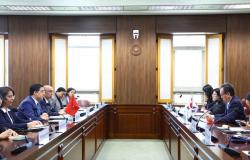Par Hajar Ben Hosain
The Chamber of Advisors adopted, on Tuesday, May 6, to a large majority (32 votes for)Bill 33.22 relating to heritage protection. This text, defended by the Minister Delegate to the Head of Government responsible for relations with Parliament, spokesperson for the government Mr. Mustapha Baitas, marks an important stage in the harmonization of the Moroccan legal framework with international standards in terms of preserving cultural, natural and geological heritage.
Bill n ° 33.22 relating to the protection of heritage mainly concerns the introduction of new definitions relating to the different categories of the cultural, natural and geological heritage, in harmony with the concepts recognized on an international scale in matters of cultural heritage and the new definitions adopted by UNESCO, according to Mustapha Baitas.
The Minister added that this bill introduces several key concepts, notably that of ” Historical groups “, Which designates sets of real estate presenting an architectural, historical or cultural value. He also joined a category dedicated to “ underwater cultural heritage », Enclosing the remains linked to human activity, presenting a cultural, historical, archaeological, scientific or artistic value.
Read also: Intangible cultural heritage linked to eating practices: Morocco at the heart of a UNESCO global project
The text also includes the notion of ” Intarable cultural heritage “, Which refers to a series of practices, representations, tools, objects, works and cultural spaces considered by communities and individuals as part of their cultural heritage. In addition, he introduces the concept of “ natural heritage » et « geological heritage », Covering the natural and geological elements having a particular value. Finally, the project defines the system of ” living human treasures », Aiming to transmit knowledge and skills in order to ensure the preservation of the intangible heritage.
The project is part of a context marked by major archaeological discoveries in Morocco and by the desire to enhance the heritage on an international scale, in particular with a view to the 2030 World Cup, which Morocco coorganizes. In parallel, he responds to diplomatic and cultural issues, especially in the face of the attempt to appropriate the Moroccan caftan and zelge by another country with UNESCO. This dynamic has thus motivated the integration of specific provisions aimed at protecting the intangible cultural heritage.
As a reminder, the project updates the definition of national cultural heritage in order to make it compliant with international conventions ratified by the Kingdom, in particular the 2003 Convention for the safeguarding of the intangible heritage. However, some professionals in the art and culture sector express concerns concerning the criminalization of certain offenses, fearing that an excessive judicialization would slow down the mobility of works and discourage cultural actors.








